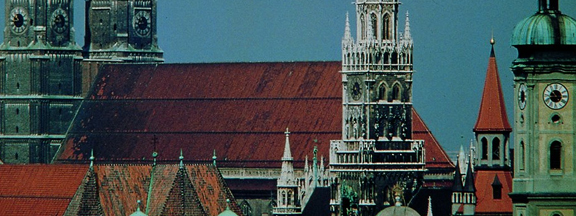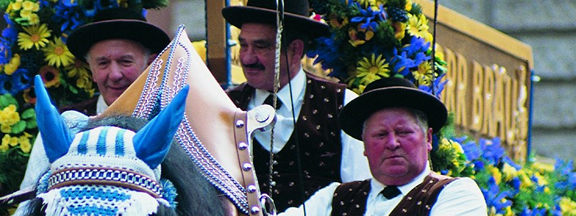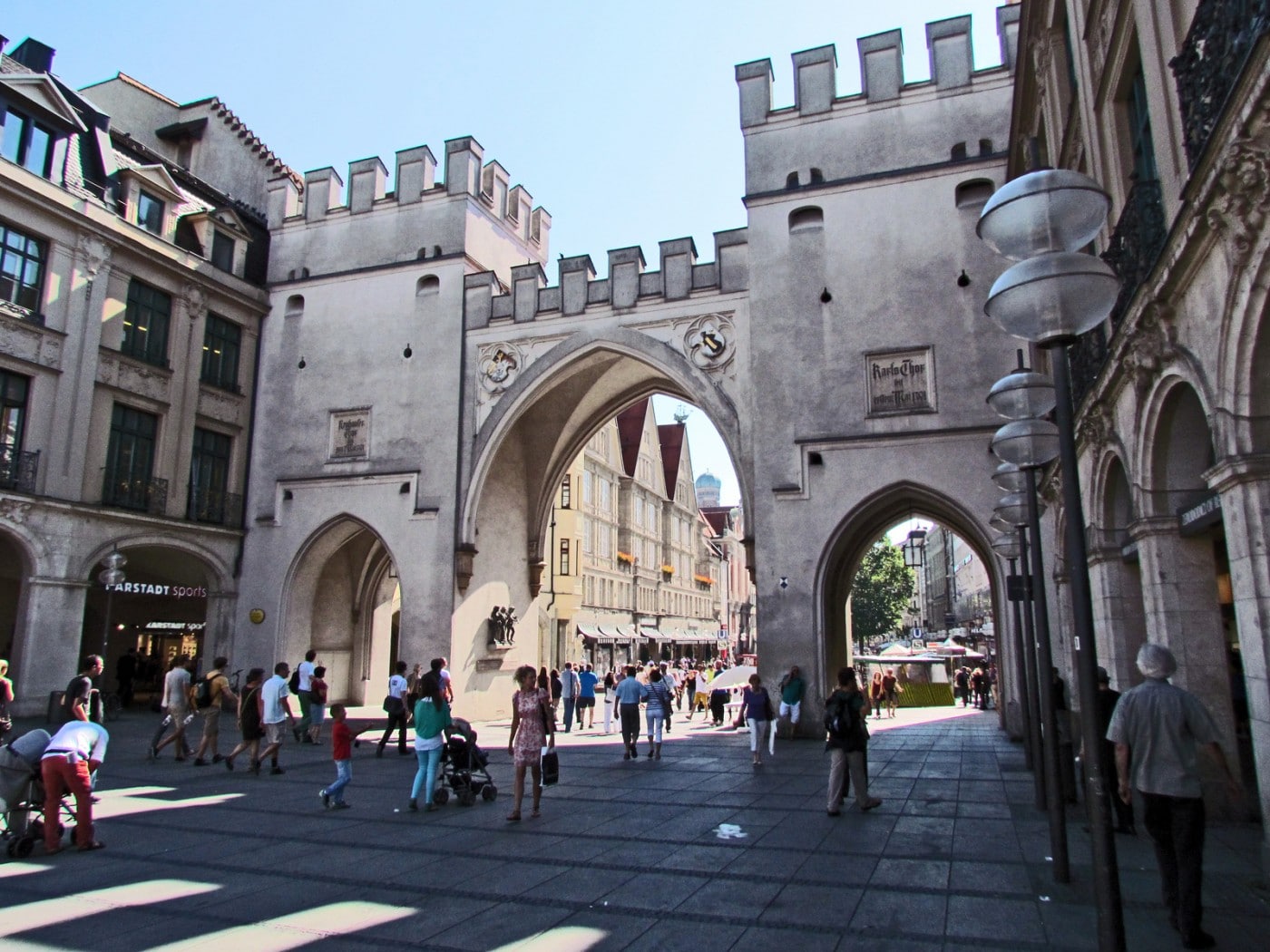The capital of beer-brewing Bavaria, Munich is best known for its Hofbräuhaus beer hall and its annual Oktoberfest, the world’s largest beer bash. But Germany’s third-largest city is much more: a sophisticated yet laid back metropolis of more than a million people, where cutting-edge high technology and old Bavarian traditions comfortably coexist in “the city of laptops and lederhosen.”
 Founded loosely in 1158, Munich celebrated its 850th birthday in 2008. It’s often called “the northernmost city in Italy” because of its pastel-painted buildings and abundant sunshine. With 58 dramatic and musical theaters, 41 museums, 7 orchestras, 2 top soccer teams, and its world-famous beer festival, Munich attracts more than 4.5 million visitors a year.
Founded loosely in 1158, Munich celebrated its 850th birthday in 2008. It’s often called “the northernmost city in Italy” because of its pastel-painted buildings and abundant sunshine. With 58 dramatic and musical theaters, 41 museums, 7 orchestras, 2 top soccer teams, and its world-famous beer festival, Munich attracts more than 4.5 million visitors a year.
In a nationwide poll, even 75% of Germans said if they could choose to live anywhere in their own country, they’d live in Munich. I know how they feel. I lived there myself for ten years and it’s still my favorite city in Germany.
Whenever friends came to visit me, I always took them on a walking tour, starting from the Marienplatz square in the heart of the city. Its defining landmark is the neogothic Neues Rathaus (New Town Hall), built between1867 and1908. Be there at 11 a.m., noon, or 5 p.m. when the historical Glockenspiel on the city hall chimes its bells and dancing figures rotate in and out of the mechanical clock. (Tip: The dense crowds watching this spectacle, especially in summer, are a target for pickpockets in an otherwise very safe city. For a better view and no worries about your wallet, go to the third or fourth floor of the big Hugendubel bookstore across from city hall and watch the performance from the picture windows there.)

Several museums are worth a visit when you’re strolling around this part of the city center. The charming little Spielzeug museum, in the old tower near the city hall, is chock full of antique toys, including dolls and teddy bears, that will delight both children and adults. A few blocks away toward the Isartor (Isar Gate), the Bier-und-Oktoberfestmuseum, housed in a 14th-century building, showcases Munich’s most popular beverage and annual festival. After touring the museum and watching a short film about the history of Oktoberfest, quench your thirst with a glass of local beer at the small tavern on the museum’s ground floor.
From the Marienplatz, walk four blocks up the Weinstrasse and Theatinerstrasse to the Residenz, a large complex of palaces built around seven courtyards, former home of the Wittelsbach family who ruled Bavaria from the Middle Ages until 1918. In addition to 130 richly decorated rooms filled with furniture, paintings, tapestries, porcelain, and other antiques, it houses the Schatzkammer (royal treasury containing gold, silver, and jeweled objects) and the recently restored rococo Cuvilliés-Theater. Although 90% of the building was destroyed by bombs in World War II, the Residenz has now been restored to much of its former glory.
If you’re at the Marienplatz between 10 a.m. and noon, head to the nearby Weisses Bräuhaus for the traditional Munich mid-morning “second breakfast” of Weisswurst (fresh white veal-and-pork sausage) with sweet Bavarian mustard, soft pretzels, and a glass of Weissbier (or Weizenbier, wheat beer). But don’t delay. Most Munich restaurants serve Weisswurst only before noon (a holdover from earlier days of no refrigeration, when fresh sausages had to be eaten before they spoiled).

Another good place to eat at the Marienplatz is the Ratskeller München, a restaurant in the basement of the ornate city hall, which seats 1,200 people but avoids seeming like a big beer tavern. Popular with locals and tourists alike, the Ratskeller offers a large selection of traditional, modern, and seasonal Bavarian dishes served in several small dining rooms and intimate alcoves with beautiful vaulted and frescoed ceilings, iron light fixtures and wooden wainscoting.
The Marienplatz is the takeoff point for several other walking tours in this part of town. Only a couple of blocks away, you’ll find the Viktualienmarkt, Munich’s colorful open-air market with rows of stalls selling fruits, vegetables, meats, fish, flowers and prepared foods for takeaway. At the big beer garden in the center of the market, you can order traditional Bavarian dishes or bring your own picnic to eat with a glass of fresh beer. Nearby, the Münchner Suppenküche is a popular soup stand serving more than a dozen hearty soups and stews made from fresh, seasonal ingredients.
Starting at the Marienplatz again, walk up the Kaufingerstrasse, the street at the beginning of the pedestrian zone, in the direction of the Karlstor (Karl’s Gate, also called Stachus). This is Munich’s major shopping street, lined with department stores, boutiques, restaurants and cafes. Along the way, turn right on Augustinerstrasse to visit the Frauenkirche (or Dom), the brick cathedral whose two iconic green domes define the skyline of Munich.
Continuing up the pedestrian street (which changes its name to Neuhauser Strasse), my favorite place to stop for a beer and a good meal is the Augustiner Grossgastätten, one of Munich’s most popular beer taverns. You’ll recognize it by the large outdoor eating area in front (in good weather) and the name “Augustiner Bräu Ausschank” in old-fashioned lettering on the beer hall side of the stone building with arched windows. Indoors you’ll find vaulted ceilings, dark wood paneling, and walls decorated with deer heads, antlers, and old framed prints of people in Bavarian costumes. The adjacent “Augustiner Restaurant” serves meals in more elegantly appointed dining rooms. And at the back of the restaurant there’s a small beer garden in an enclosed courtyard resplendent with baroque and rococo flourishes.

There’s plenty to do beyond this area, too. Art lovers can spend several days in the Alte Pinakothek art museum, with more than 800 paintings from the Middle Ages through the rococo period; the Neue Pinakothek, with European paintings and sculptures from the late 17th to early 20th centuries; and the Pinakothek der Moderne, a complex of four museums of modern art, graphics, architecture, and design. The massive 1930s-era Haus der Kunst, offers a variety of temporary exhibitions, and several smaller art museums, such as the Villa Stuck and the Städtische Galerie im Lenbachhaus are well worth a visit, too.
History buffs should head to the Münchner Stadtmuseum, with its new exhibit on the history and culture of the city. Across the square, the Jüdisches Museum documents the history of Munich’s Jewish community from the 13th century. And the Bayerisches National Museum has three floors of fascinating exhibits on the arts, crafts, and folklore of Bavaria, including a wonderful collection of old Nativity scenes.
Fans of science and technology shouldn’t miss the magnificent Deutsches Museum, whose scientific exhibits attract more visitors than any other museum in Munich. Branches of the museum in separate locations house the historic trains, buses, cars and bicycles (Deutsches Museum Verkehrszentrum) and 60 airplanes and helicopters (Deutsches Museum Flugwerft Schleissheim).

The recently redesigned and expanded BMW Museum is a must for anyone interested in cars and motorcycles. Combine your visit to the museum with a guided tour of the Bavaria Motor Works Plant (reservations required) and a walk through the futuristic BMW Welt with shops, restaurants and exhibits of more BMW automobiles.
Another popular destination is the Bavaria Filmstadt, where you can tour the film and television studios, learn how special effects are done, and watch stuntmen perform daring feats on an exterior set.
You can spend an entire day at Schloss Nymphenburg, a huge baroque castle and park in the western part of Munich, with museums of painting and porcelain, the royal apartments and ballroom, and royal stables housing a fine collection of ornate, guilded coaches and sleds. More baroque palaces and pavilions are scattered around the spacious gardens. And another ensemble of important Bavarian baroque castles, parks, and paintings can be found at Schloss Schleissheim, just north of the city.

For a change of scenery, relax at the Englischer Garten, the largest urban garden in Europe, along the banks of the Isar River. Hike-and-bike trails crisscross this 900-acre expanse of greenery, just northeast of the city center. Take your own picnic or eat at one of the park’s four pleasant beer gardens. (Tip: At the southern end of the garden, on Prinzregentenstrasse between the Haus der Kunst and the Bavarian National Museum, stand on the stone bridge to watch athletic young daredevils from all over the world surf the waves on the Isar River.)
Finally, if you enjoy watching wild animals in natural habitats instead of cages, spend a day at the famous Munich zoo, Tierpark Hellabrunn, where rare Siberian tigers bask in their green surroundings, polar bears swim in a glassed-in pool, penguins come out for a walk in the winter snow, and exotic birds flap their wings among tropical foliage. And yes, the zoo has a beer garden, too.
{niftybox width=600}The country code for Munich is 49.
Where to Sleep
Platzl Hotel: A 4-star Superior hotel conveniently located in Munich’s historical Altstadt (Old City) near many of the tourist attractions. Several categories of comfortable rooms that combine traditional and modern decor. The two good restaurants within the hotel have plenty of Old Munich ambience. Sparkassenstrasse 10, tel. (089)-23-70-30, info@platzl.de , www.platzl.de
Hotel Torbräu: The oldest hotel in the heart of Munich, located in a 15th-century building, which mixes traditional and contemporary style in a pleasing way. Restaurant in the hotel features Italian food, with an emphasis on Tuscan dishes. Tal 41, tel. (089)-24-23-40, info@torbraue.de , www.torbraeu.de
Exquisit Hotel: A 4-star boutique hotel centrally located near the Sendlingertor and close to tram and subway stops. Modern style with classical touches, and a nice breakfast buffet. Pettenkoferstrassse 3, tel. (089)-551-99-00, info@hotel-exquisit.com , www.hotel-exquisit.com
Where to Eat and Drink
Ratskeller München: An institution in Munich, enjoyed by locals and tourists alike. Dine on a wide selection of traditional and contemporary Bavarian specialties, many of which feature organic products (identified as “BIO”), served in several dining areas featuring Old Munich decor . Extensive wine and beer list. Marienplatz 8 (in the basement of the ornate Rathaus, New City Hall), tel. (089)-21-99-890,www.ratskeller.com
Weisses Bräuhaus: The place to go near the Marienplatz for your Munich “second breakfast” of white sausages and wheat beer, as well as good traditional Bavarian food. Tal 7, tel. (089)-290-13-80,www.weisses-brauhaus.de
Augustiner Grossgastätten: A combination of rustic beer hall (quiet, fun, but not rowdy) and adjacent white-tablecloth restaurant with a small beer garden, all serving some of Munich’s best beer and traditional foods for reasonable prices. Popular with tourists, but also frequented by locals, which is always a good recommendation. Neuhauser Strasse27 (on the pedestrian street), tel. (089)-23-183-257,www.augustiner-restaurant.com
Hofbräuhaus: Munich’s most famous beer tavern. The touristy ground floor is noisy and boisterous, with an oompah band and foaming beer served in 1-liter mugs. Locals know to go up the wide stone staircase to the first floor, which is much quieter, with warm wooden wainscoting, intimate alcoves, white linens, and a friendly waitstaff. You can also sit outdoors in the pleasant beer garden in the courtyard. Platzl 9, tel (089)-290-13-60, www.hofbraeuhaus.de
Andechser am Dom: Next to the famous Frauenkirche, featuring beer from Kloster Andechs brewery south of Munich. Known for its good cuisine and nice decor. Weinstrasse 7a, tel. (089)-29-84-81,www.andechser-am-dom.de
Wirtshaus Ayingers am Platzl: A quiet, tastefully decorated restaurant-tavern across from the Hofbräuhaus. Known for its refined “new German cuisine” based on traditional Bavarian recipes and regional ingredients, served in large portions. Platzl 1-A, tel. (089)-23-703,www.platzl.de/gastronomie/wirtshaus-ayingers/wirtshaus-ayingers
Must See
The Deutsches Museum: One of the world’s largest (and best) technological museums, with exhibits geared to people of all ages. Separate branches focusing only on transportation are located elsewhere: the Deutsches Museum Verkehrszentrum (trains, buses, cars, etc.) and the Deutsches Museum Flugwerft Schleissheim (airplanes).
Englischer Garten: The largest urban park in Europe and a magnet for Münchners of all ages. Hike, bike, picnic, quaff beer in a beer garden, read, relax, sunbathe in the nude—you can do it all at the Englisher Garten
Tierpark Hellabrunn: Munich’s great zoo, a fun all-day outing for the family. The animals look so content in their natural surroundings that you’ll wish you lived there, too. Restaurant, beer garden, and snack stands on site, as well as a petting zoo for the kids. www.tierpark-hellabrunn.de

